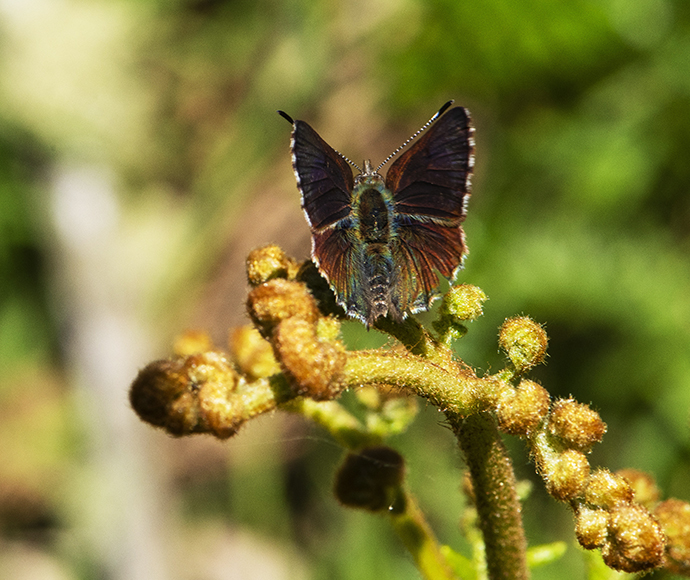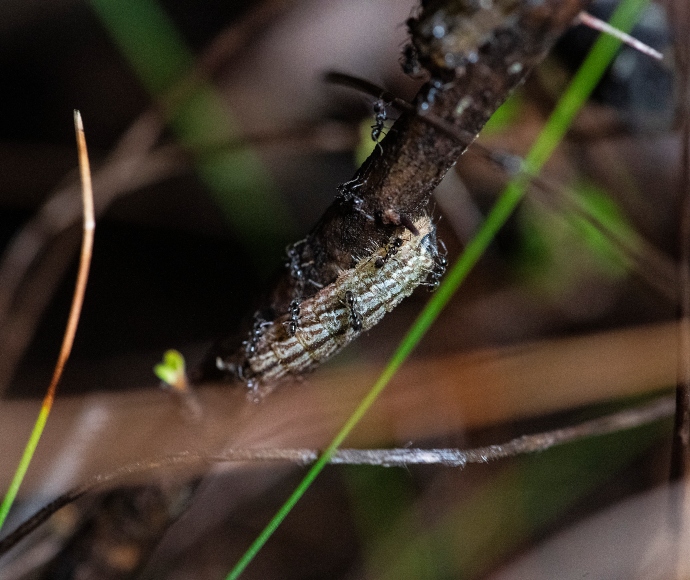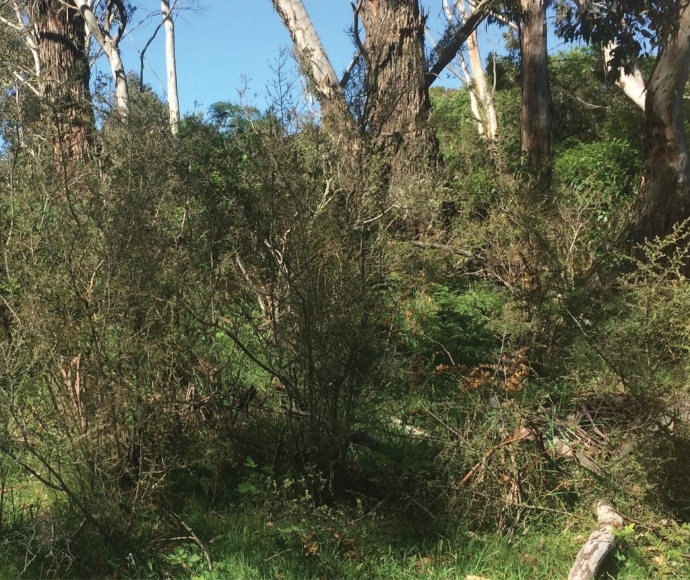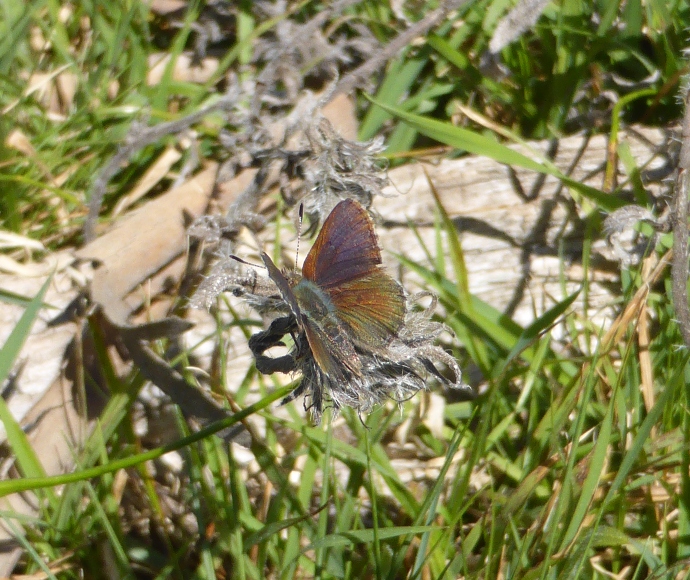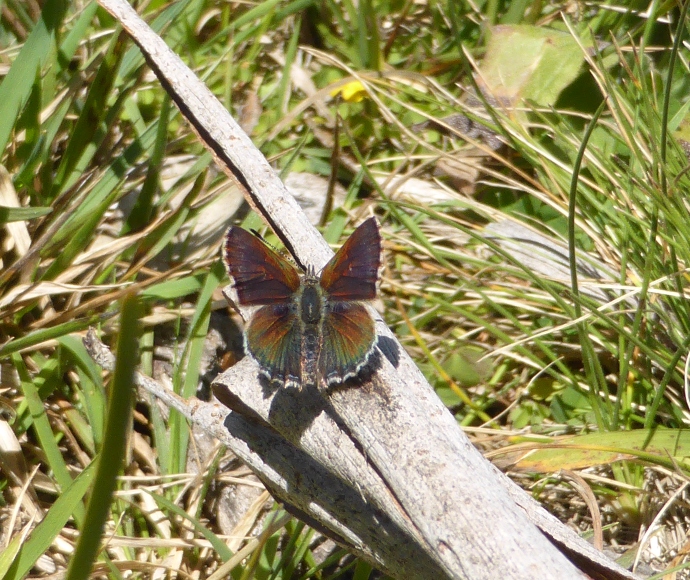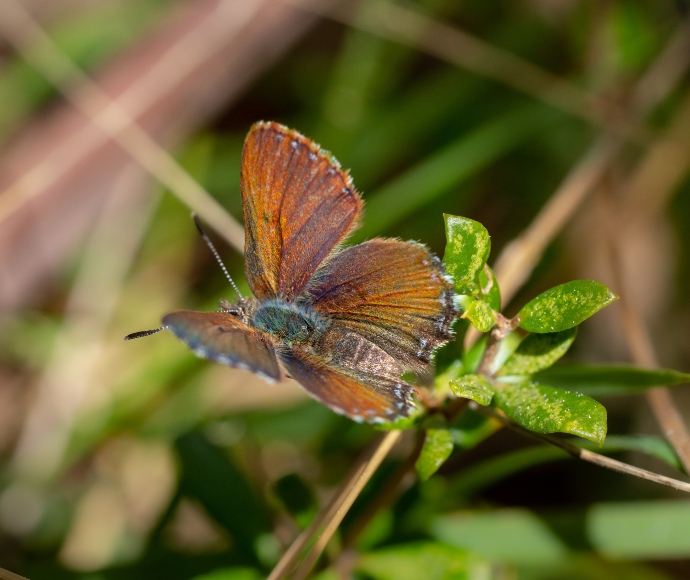The endangered purple copper butterfly (Paralucia spinifera) is only known to occur in the Central Tablelands of New South Wales, around Bathurst, Oberon and Lithgow.
This species was identified by scientists in 2021 as one of 26 Australian butterflies at greatest risk of extinction. We don’t know exactly how many individuals remain, but it is possible that more locations will be identified where the butterfly’s food plant occurs. These may lie outside the species' currently known distribution.
Purple copper butterflies are important pollinators and play a role in food chains The species has a mutualistic relationship with the ant Anonychomyrma itinerans, which protects caterpillars from predators in return for a sugary honeydew produced by the caterpillars. As herbivores, the caterpillars eat the leaves of plants and cycle nutrients back into the soil through their faeces. They also serve as food for animals such as birds, spiders, and insects like dragonflies, flies and wasps.
Without urgent conservation action, this species is at risk of extinction. At Saving our Species, we are committed to securing threatened species. Let’s take a closer look at this rare and endangered butterfly, what’s being done to save it and how we can all help.
An update on the purple copper butterfly conservation project
Threats to the purple copper butterfly include habitat loss and modification through clearing, spraying, grazing, inappropriate use of fire, weed invasion and habitat disturbance by feral pigs.
Under the Saving our Species program, the NSW Government is funding several actions to conserve the butterfly, including:
- monitoring and survey to help find more butterflies
- pest and weed control
- community engagement so people can keep a look out and report any sightings
- ecological burns to ensure healthy habitat for the butterfly.
About the purple copper butterfly
What does it look like?
The purple copper butterfly is a small butterfly with a thick body and a wingspan of only 20–30 mm. The upper sides of its wings are purple, black or deep brown, with a bronze or green iridescence when they’re in the sun. The undersides of its wings are patterned with subtle brown, black and grey. Its black antennae are dotted with white spots and have a black tip.
Butterflies can emerge from late August through to early November and they usually fly between 10 am and 2 pm on warm sunny days with little or no wind.
Adult males fly rapidly at about one metre from the ground and rest in the sun with their wings parted. Females fly less rapidly and tend to stay closer to the host plant, a native blackthorn shrub, on which they lay their eggs. Typical behaviours include territorial chasing and spiralling courtship chases, with one female being pursued by several males. They also like to sit in the sun and feed on nearby flowers.
Caterpillars grow to about 22 mm in length and are light green with darker longitudinal markings. They are nocturnal and can be found crawling along the blackthorn stems and feeding on the leaves from 10 pm to 5 am between November and January. They will be attended by between one and 15 ants, with other ants patrolling a line between the feeding caterpillar and the ant nest at the base of the plant. Ants also roam around the host plant, attacking other insects that they find.
Where is it found?
The purple copper butterfly is found in the area bordered by Bathurst, Portland, Lithgow and Oberon in the Central Tablelands of New South Wales, with an outlying population at Mount David and recently in Namadgi National Park in the ACT. It is also likely to occur in new areas yet to be discovered across New South Wales and the ACT. It is one of Australia’s rarest butterfly species.
The following features are common to known sites:
- altitude greater than 850 m
- presence of native blackthorn (Bursaria spinosa subsp. lasiophylla)
- presence of attendant ant (Anonychomyrma itinerans)
- heavy frosts and/or occasional snow
- 3–4 hours of exposure to direct spring sunlight.
What is its habitat?
The purple copper butterfly lives in open woodland or open forest with a sparse understorey that is dominated by the shrub native blackthorn – Bursaria spinosa subsp. lasiophylla.
Native blackthorn is the only food plant of the purple copper butterfly larvae (caterpillar). The caterpillar’s distinctive grazing pattern is evident from October to May. Grazed native blackthorn will have leaf buds or small leaves replacing the grazed leaves; entire plants can be defoliated of mature foliage. Often, the stems are eaten from the ground up, as opposed to the grazing patterns of beetles that graze from the tips of the plant down. Conserving the small areas of blackthorn that remain is critical to saving the butterfly from extinction.
Native blackthorn is an erect, spindly, often multi-stemmed shrub that generally grows to approximately 2 metres tall. It has spines along the primary branches and the dark green foliage is sometimes sparse.
It is most obvious in spring to summer when mass flowering occurs on the outer branches. The small white to cream flowers have a strong fragrant perfume that attracts a range of insect pollinators.
Blackthorn grows at high elevation sites on heavier clay soils, in eucalypt woodlands throughout south-eastern Australia. In the NSW Central Tablelands, stands of blackthorn occur in remnant woodland areas along roadsides, in various Crown lands and on private property.
What is its life cycle?
The butterfly’s life cycle relies on a ‘mutualistic’ relationship with the ant (A. itinerans) and the presence of native blackthorn. After mating, the female lays her eggs on or near blackthorn bushes, at the base of which there are nests of the attendant ants. During the 14 to 17 days the caterpillars take to hatch, the attendant ants constantly patrol the blackthorn. When the larvae hatch, they are immediately tended by ants.
As the caterpillars grow, the ants move them underground into their nest during the day and out at night to continue grazing on the native blackthorn leaves. The ants’ efforts are rewarded with a sugary honeydew from a gland on the caterpillar’s back. Pupation occurs between December and August within the underground ants' nest.
Counting Coppers citizen science project
The Counting Coppers project, run by Butterflies Australia and the NSW Government’s Saving our Species program, asks citizen scientists to record their sightings during the spring butterfly season through the easy-to-use Butterflies Australia app.
The app can be downloaded for free from the Google and Apple app stores.
By becoming a citizen scientist and Counting Coppers, you are helping to collect population and distribution information that contributes to our understanding of this endangered butterfly so that we can better plan for its conservation and management.
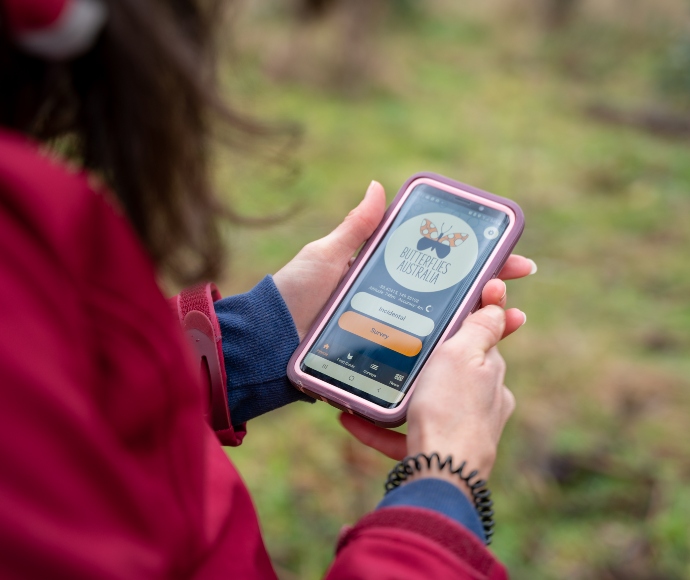
You can record butterfly sightings using the Butterflies Australia app
How to register
Watch our Counting Coppers project video on how to register.
How to record a sighting
Watch our video on how to record sightings.
Important things to remember before you go Counting Coppers:
- Sightings can be recorded from late August until early November, when the butterfly is active.
- Butterflies are best spotted on sunny, calm days between 10 am and 2 pm.
- Adults fly on warm cloudless days.
- They only live at elevations above 850 m.
- They can be found close to native blackthorn habitat.
- They have a symbiotic relationship with a species of ant.
Citizen scientists who are involved in monitoring the purple copper butterfly take note of:
- when the purple copper butterflies become active
- where they are sighted
- how many individuals are sighted.
Acknowledgements
The purple copper butterfly conservation project is led by the Saving our Species program in partnership with:
- Central Tablelands Local Land Services
- Lithgow City Council
- Lithgow Oberon Landcare Association
- NSW National Parks and Wildlife Service
- private landholders.
